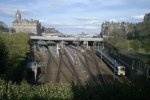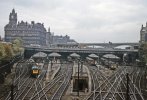Inversnecky
Member
Are there any informative resources about track design (thinking of in urban areas and station vicinities)? How switches, slips and crossings are organised and laid out? Are the more complex elements built are required, or do they generally simpler if space allows?
As a child I was always amazed at the complexity on some routes. And wondered if there was a ‘design manual’.
As a child I was always amazed at the complexity on some routes. And wondered if there was a ‘design manual’.



